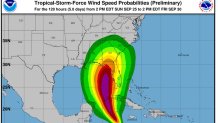A tropical storm warning was issued for the lower Florida Keys Sunday as Tropical Storm Ian was set to rapidly strengthen, with a large stretch of the Gulf Coast of Florida preparing for a possible landfall later this week.
While South Florida remained out of the cone of concern, forecasters said Ian could become reach major hurricane strength before making an impact on the northern part of the state in the coming days.
Ian had maximum sustained winds of 70 mph as it moved northwest at 13 mph, the National Hurricane Center in Miami said Sunday. Ian was about 140 miles south of Grand Cayman and 390 miles southeast of the western tip of Cuba.
The tropical storm warning was issued Sunday night for the lower Florida Keys from Seven Mile Bridge southward to Key West, including the Dry Tortugas.
A storm surge watch was also issued for the Florida Keys from the Card Sound Bridge westward to Key west, including the Dry Tortugas, and for the west coast of Florida from Englewood southward to the Card Sound Bridge, including Florida Bay.
A tropical storm watch was issued for the west coast of Florida from Englewood southward to Chokoloskee
U.S. & World
A hurricane warning had been issued earlier Sunday for Grand Cayman and the Cuban provinces of Isla de Juventud, Pinar del Rio, and Artemisa. A tropical storm warning was issued for for the Cuban provinces of La Habana, Mayabeque, and Matanzas.
A tropical storm watch was in effect for Little Cayman and Cayman Brac.
Get a weekly recap of the latest San Francisco Bay Area housing news. Sign up for NBC Bay Area’s Housing Deconstructed newsletter.
Despite Ian’s projected path of staying to the west, other parts of South Florida could still be placed under a tropical storm watch in the coming days due to expected weather conditions from the system.
Limited flash flooding and urban flooding was possible with rainfall across the Florida Keys and the Florida peninsula through mid next week, NHC forecasters said.
On the forecast track, the center of Ian was expected to pass near or west of the Cayman Islands Monday. Ian will then move near or over western Cuba Monday night and early Tuesday and emerge over the southeastern Gulf of Mexico on Tuesday.
Ian is then expected to move on a path to the Gulf Coast of Florida, with the center staying to the west of the Florida Keys, according to the latest advisory.
There was increasing confidence that life-threatening storm surge and hurricane-force winds over portions of western Cuba could occur beginning late Monday. Up to 16 inches of rain could fall in parts of Cuba, according to the NHC.
Despite being out of the cone of concern, officials were encouraging South Florida residents to stay vigilant.
The City of Fort Lauderdale and the City of Miami distributed sandbags to residents Sunday.
Many residents who were filling up the bags said it was better to be safe than sorry, including Alex Greedy, who was getting them for his mother.
"She lives in an area prone to flood and water comes in sometimes on just a rainy day," Greedy said.

Florida Gov. Ron DeSantis activated the state's National Guard on Sunday ahead of the storm's expected impact later in the week.
The governor's declaration frees up emergency protective funding to address potential damage from storm surge, flooding, dangerous winds and other weather conditions throughout the state.
DeSantis expanded the declaration of a state of emergency Saturday to include the entire state.
"It's important to point out to folks that the path of this is still uncertain. The impacts will be broad throughout the state of Florida," DeSantis said at a news conference Sunday. "So from the Tampa Bay area all the way up to Escambia County along Florida's Gulf Coast you could potentially see it make landfall in any of those places as of right now."
President Joe Biden has postponed a trip to South Florida next week due to Tropical Storm Ian, the White House announced Saturday.
Biden approved an emergency declaration for the state of Florida Saturday due to Ian, the White House said in a statement.
The declaration authorizes the Department of Homeland Security and Federal Emergency Management Agency (FEMA), to coordinate all disaster relief efforts resulting from Ian.



